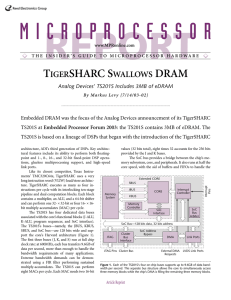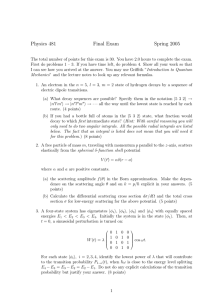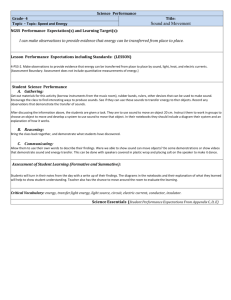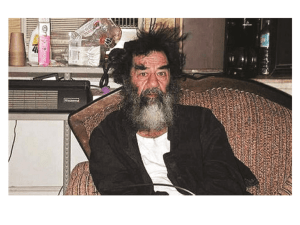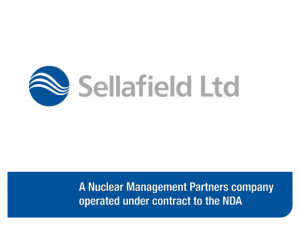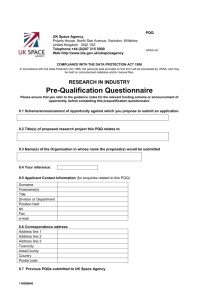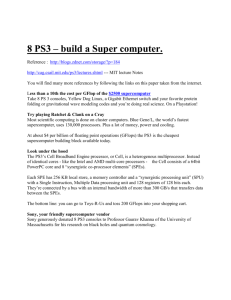Air Force Science & Technology Issues & Opportunities Regarding
advertisement
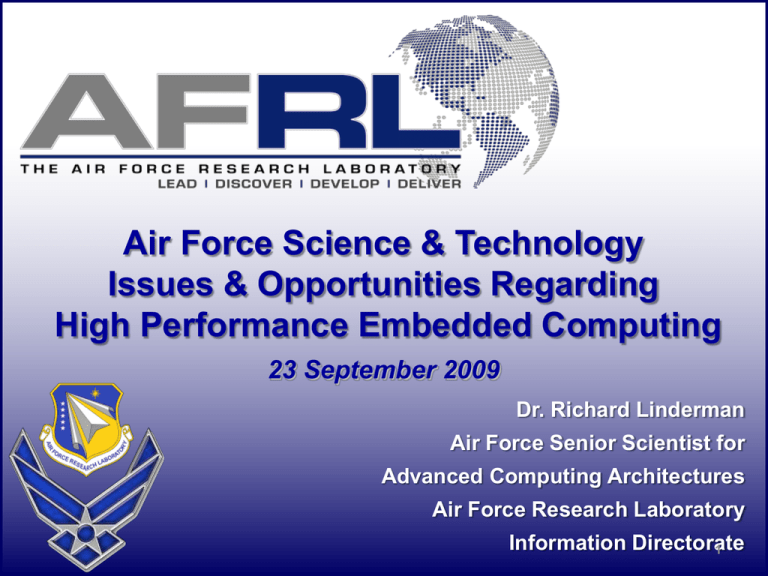
Air Force Science & Technology Issues & Opportunities Regarding High Performance Embedded Computing 23 September 2009 Dr. Richard Linderman Air Force Senior Scientist for Advanced Computing Architectures Air Force Research Laboratory Information Directorate 1 USAF S&T Vision The mission of the United States Air Force is to fly, fight and win… in Air Space Air, Space and Cyberspace. Guides USAF S&T goals Cyber Links S&T to Warfighter2 AFRL Mission Leading the discovery, development, and integration of affordable warfighting technologies for our air, space and cyberspace force. It’s not just about the science… …it’s about leadership in S&T 3 Challenges by Domain • Air: Persistant air dominance is at risk – – Increasingly effective air defenses – Light-speed war possibilities are terrifying Proliferation of 5th gen fighters, cheap cruise missiles, and UASs • Space: Now a contested domain – – Increasingly important Increasingly vulnerable • Cyber: Cyber warfare has begun – – – We don’t control the battlespace We rely on it more and more We can’t find the enemy 4 Opportunities – Air: Across the Technology Spectrum • Endurance – Efficient aerodynamics, efficient propulsion, lightweight structures • Alternative Fuels – Fischer-Tropsch, biomass, carbon sequestration • Sensors – 360 degree coverage, structural load-bearing antennas • Speed – Hypersonics, thermal, flight controls, maneuverability, payloads • Thermal Management – Produce less heat, tolerate more heat, dissipate more efficiently, convert more effectively • Modeling & Simulation – Virtual prototyping, live-virtual-constructive environments • Manufacturing Technology – Lean, diagnostics, just-in-time production • UASs – Swarming, semi-autonomous then autonomous, learning, healing • Micro Air Vehicles – Sensor miniaturization, flight agility, autonomy • Integrated Systems Health Management – Self-reporting systems, autonomous reconfiguration to maintain mission capability • Responsive to needs of sister services, needs of the Nation 5 Opportunities – Air: “We Can Control the Vertical” • C2ISR (High-to-Medium Altitudes) - Endurance - Aerodynamics - Propulsion Layered Sensing - Sensors - Processing & Integration • ATTACK (Medium Altitudes) - Swarming Brains (UAVs) - Programming & Processing • URBAN & SOLIC (Low Altitudes) - - Maneuverability - Morphing structures, bio-mimetics Miniaturization - Micro- & NanoAutonomy - Sensors - Game Theory & Processing 6 Opportunities – Space: SSA & ORS • Space Situational Awareness – – – – • High resolution imaging Electro-optical phenomenology Advanced astrodynamics Modeling and decision aids Operationally Responsive Space – – – – Plug ‘n’ Play Satellites Small vs Large Satellites Quick Launch Fast On-Orbit Checkout 7 Opportunities – Cyber: Robust, Resistant, Resilient • Must be able to take a series of punches, jabs, feints...and survive! • “Fight through the Attack!” – Endure...mitigate...recover... reconstitute...get up...move forward! • Move beyond “One Air Force – One Network” to “Defending the Nation” • Evolve to a polymorphic system of systems that naturally favors: – – – – – – Stability Security Cyber-Sensing Partitionable Rapid Reconstitution Focus on Protecting & Delivering Data 8 Ten Technical Directorates Major AFRL Facilities WRIGHT-PATTERSON PROPULSION (RZ) AIR VEHICLES (RB) SENSORS (RY) MATERIALS AND MANUFACTURING (RX) COLLABORATIVE C2 (RI) 711th HUMAN PERFORMANCE WING (HPW) – HUMAN EFFECTIVENESS (RH) EDWARDS ROME HANSCOM INFORMATION (RI) SURVEILLANCE (RY) BATTLE SPACE ENVIRONMENTS (RV) ELECTROMAGNETICS (RY) ROCKET PROPULSION (RZ) AFRL HQ BALLSTON AIR FORCE OFFICE OF SCIENTIFIC RESEARCH (AFOSR) BROOKS MESA WARFIGHTER TRAINING RESEARCH (RH) KIRTLAND DIRECTED ENERGY (RD) SPACE VEHICLES (RV) 711th HPW - BIOEFFECTS (RH) - AEROSPACE PHYSIOLOGY (RH) - USAFSAM TYNDALL AIR BASE TECHNOLOGY (RX) EGLIN MUNITIONS (RW) 40 Sites World-Wide 10 Focused Long Term Challenges and Discovery FLTC #1 Anticipatory Command, Control & Intelligence (C2I) FLTC #2 Unprecedented Proactive Intelligence, Surveillance and Reconnaissance (ISR) FLTC #3 Dominant Difficult Surface Target Engagement/Defeat FLTC #4 Persistent & Responsive Precision Engagement FLTC #5 Assured Operations in High Threat Environments FLTC #6 Dominant Offensive Cyber Engagement FLTC #7 On-demand Force Projection, Anywhere FLTC #8 Affordable Mission Generation & Sustainment Discovery Questions the Air Force doesn’t even know to ask 11 Rapid Reaction Solution for Brownout PhLASH - Photographic Landing Augmentation System for Helicopters 9 months from Idea to Demo Problem • Helicopter landings at arid sites stir up blinding dust clouds (Brown-out) Technologies • High Resolution Near-IR flash photography • Advanced Image processing / reconstruction based on GPS location Solution • High resolution image of the landing zone and fly into the image 12 Micro Air Vehicle Development • Built many mission specific 2003 development designs •Bomb Damage Information sensing, chem/bio sensing, terminal guidance improvements, weaponization, and general R&D activities for both AFRL and other government agencies • Optimized Tandem wing design • Air launch and dismount tube launch • Pictures show the family of AFRL MAVs from 2003 to present Air Vehicle Launcher 2009 13 Bio-Inspired Micro Air Vehicles • Characterize aeromechanics and scalability of bat flight • Bat wing motion has many Degrees of Freedom, unlike insects/birds • Highly flexible wing structure & membrane • Arrays of raised hair sensorsactuators that may provide flow sensing & influence flight control • Active vision control (fly eye) for imaging, tracking and guidance 2015 Goal: Bird-Sized MAV Digitized wing motion Bio-Inspired: Fly eye & Bat Flight Kinematics 2030 Goal: Insect-Sized MAV 14 Multi-Layer Sensing SensorCraft 15 AFRL Staring Sensor Technology Day (AngelFire) IR (Night Stare) IRAQ Area B Multispectral (SPIRITT) Sensor Radar All Weather Video SAR (Gotcha) Area B 16 Synthetic Aperture LADAR (SAL) Synthetic Aperture LADAR for Tactical Imaging (SALTI) • Image resolution of current systems limited by size of physical aperture • Demonstrated world’s first airborne synthetic aperture LADAR • ACC Commissioned Advanced Technology Demonstration (ATD) • Synthetic and sparse aperture methods provide resolution better than allowed by the aperture and the atmosphere Temporal Synthesis Cross Over (Phased Spatial Synthesis (Synthetic Aperture) Arrays) Translation (Sparse Apertures) Translation Only & Separation Separation Only Single SAL beam ideal for high resolution imaging 17 COUNTER: Cooperative Operations in Urban Terrain • Automated control system for multiple UASs •Allocate Resources •Route Vehicles •Avoid no-fly zones •Respond to alarms •Data collection interface for ISR •Steer sensors •Fuse Information Yuma Flight Test – Nov 08 (4 Vehicles – 2 Zaggi’s, 1 Bat-III, 1 Acturus T-16) 18 Operationally Responsive Space • Apply operational aircraft concepts to space systems • Tailored mission capabilities • Rapid Build-Up/Turn times • Air Tasking Order responsiveness • Satellite buses with plug-and-play payloads • Sustained high operations tempo Ground Handling Satellite Control Responsive Spacecraft On-Orbit Autonomy Responsive Launch Responsive Operations 19 On-Orbit Checkout Software Defined UAV Ops Center Mock-up Human Factors Engineering Reconfigurable Collaboration Environments Training Tools Automation Multi-aircraft Control Fusion Engines Software Defined Command Center is a synthesis of hardware, software and conceptual approaches with potential application to multiple command centers in the Air Force Man-machine Interfaces 20 SensorCraft Future High Altitude Long Endurance ISR Platform Global Hawk Next Generation System 24+ Hours of endurance Highly fuel efficient, 40-50 hours of endurance Single Band (X) Air to Ground sensing payload Dual Band (UHF and X), Air to Air and Air to Ground sensing for small and hidden targets Side looking 360 degree coverage Raw data to Mission Control Element Fused data to user Conventional antennas, radomes Large, embedded structural arrays Conventional wings, 139 ft Flexible active wings, 200+ ft 21 53 TFLOPSs Cell Cluster Architecture • The Cell Cluster has a peak performance of 51.5 Teraflops from 336 PS3s and additional 1.4 TF from the headnodes on its 14 subclusters. • Cost: $361K ($257K from HPCMP) •PS3s 37% of cost • Price Performance: 147 TFLOPS/$M • The 24 PS3s in aggregate contain 6 GB of memory and 960 GB of disk. The dual quad-core Xeon headnodes have 32 GB of DRAM and 4 TB of disk each. 23 Cell Cluster: Early Access to Commodity Multicore This project provides the HPCMP community with early access to HPC scale commodity multicore through a 336 node cluster of PS3 gaming consoles (53 TF). Applications leveraging the >10X price-performance advantage include: Dr. Richard Linderman, AFRL/RI, Rome, NY … but beginning to perceive that the handcuffs were not for me and that the military had so far got … Neuromorphic example: Robust recognition of occluded text large scale simulations of neuromorphic computing models Gotcha SAR GOTCHA radar video SAR for wide area persistent surveillance Real-time PCID image enhancement for space situational awareness 10 March 2009 Solving the hard problems . . . PCID Image Enhancement An Integrated Framework for Visual Cognition Cogent Confabulation Context Recognition & Prediction Concept-level recognition prediction BSB Neural Networks Object Recognition Recognition based on raw visual data Visual Front End Object/Feature Extraction Extract important visual objects and features learning, and Visual Signal Receivers 24 Hybrid Cognitive Model for Text Recognition …but beginning to perceive that the handcuffs were not for me and that the military had so far got…. BSB Recognition Perception based on neural network models …but b??i??in? to p?r?ei?e t??t ?he ?andcuffs ?ere n?? f?r me an? th?t t?e mi?itary ?ad s? fa? g?t …. Prediction Word Level Confabulation Knowledge Base (KB) but b??i??in? to p?r?ei?e t??t ?he?andcuffs ?ere n?? f?rme an? th?t t?e mi?itar ?ad s? fa? g?t y besieging to porceite twit the handcuffs fere nut furme any thit toe militar mad su fax gut but believing perceive tha she sere nun for ant that tie y lad st fat got t beginning parseile were nod fir ann the had ss far get text banishing here not far and tee gad so fangat test …… … … … … … …… … …. Prediction Sentence Level Confabulation Knowledge Base (KB) …but beginning to perceive that the handcuffs were not for me and that the military had so far got…. Text Recognition Workflow on PS3 Cluster Single PS3 sub-cluster: 1 head-node + 24 Playstation3 (PS3) workstations Head-node ps1-1, ps1-2, …, ps1-24 Collect and prepare character images Wait character images Send images to PS3 workstations Perform BSB* recall operations Wait for BSB* recall results Check and compare convergence results Send character candidates to head-node Compute wordlevel confabulation Compute sentence-level confabulation for * BSB: Brain-State-in-a-Box neural network model Scaling the Hierarchical Temporal Memory Model Run Time Performance Network capability 6.0E+07 3.0E+06 8000 Nodes per PS3 500 Nodes per PS3 2.5E+06 Maximum number of nodes Nodes per Second 5.0E+07 4.0E+07 3.0E+07 2.0E+07 1.0E+07 2.0E+06 1.5E+06 1.0E+06 5.0E+05 0.0E+00 0.0E+00 0 50 100 150 PS3s 200 250 300 0 50 100 150 PS3s 200 250 300 Scaling Spiking Neural Net Models Run Time Performance Network capability* 250 6.0E+09 Izhikevich Wilson Morris-Lecar Hodgkin-Huxley 5.0E+09 Number of synapses (x1E8) Number of neurons (x1E7) 200 Neurons/sec 4.0E+09 150 3.0E+09 100 2.0E+09 50 1.0E+09 0 1.0E+05 0 50 100 150 PS3s *Note 200 250 300 0 50 100 150 200 250 PS3s that the number of neurons and synapses that could be implemented are heavily determined by the specific network structure developed. More biologically accurate models are currently being studied and are likely to yield different numbers. 300 96 PS3’s (576 SPU cores) processing 5km Gotcha SAR Each square (.0256km2) represents processed data from an SPU ~5km Results: Gotcha VideoSAR Scalability • At 256 PS3s, each send 6 MB/sec and receives 8.4 MB/sec while headnodes each receive 200 MB/sec and send 140 MB/sec Great News for HPEC! 31 Top 500 Supercomputers June 2009 Rank 1 2 3 4 5 Site Computer/Year Vendor Roadrunner - BladeCenter QS22/LS21 Cluster, PowerXCell DOE/NNSA/LANL 8i 3.2 Ghz / Opteron DC 1.8 United States GHz, Voltaire Infiniband / 2008 IBM Oak Ridge National Jaguar - Cray XT5 QC 2.3 GHz / Laboratory 2008 United States Cray Inc. Forschungszentrum JUGENE - Blue Gene/P Juelich (FZJ) Solution / 2009 Germany IBM Pleiades - SGI Altix ICE NASA/Ames Research 8200EX, Xeon QC 3.0/2.66 GHz Center/NAS / 2008 United States SGI BlueGene/L - eServer Blue DOE/NNSA/LLNL Gene Solution / 2007 United States IBM Cores Rmax Rpeak Power 129600 1105.00 1456.70 2483.47 150152 1059.00 1381.40 6950.60 294912 825.50 1002.70 2268.00 51200 487.01 608.83 2090.00 212992 478.20 596.38 2329.60 By comparision, the world’s largest HPC (Roadrunner at Los Alamos) is 2800 teraflops (single precision) and runs in batch mode. 32 500 TFLOPS Interactive Cluster (300 Cell, 200 GPGPU) DREN Infiniband Network DREN INF INF 1GE INF 1GE Sub-Cluster Sub-Cluster Server Server 32GB 32GB – – 4TB 4TB 1GE Sub-Cluster Sub-Cluster Server Server 32GB 32GB – – 4TB 4TB 2 Nvidia TESLA 2 Nvidia TESLA 10GE PS3 PS3 PS3 PS3 PS3 PS3 PS3 PS3 PS3 PS3 PS3 PS3 PS3 PS3 PS3 PS3 PS3 PS3 PS3 PS3 PS3 PS3 PS3 PS3 DREN 24 1GE Port 2 10GE Uplink Sub-Cluster SWITCH 1 10GE Sub-Cluster Server 32GB – 4TB Phantoms (1-88) 2 Nvidia TESLA 10GE 10GE PS3 PS3 PS3 PS3 PS3 PS3 PS3 PS3 PS3 PS3 PS3 PS3 PS3 PS3 PS3 PS3 PS3 PS3 PS3 PS3 PS3 PS3 PS3 PS3 24 1GE Port 2 10GE Uplink Sub-Cluster SWITCH 2 . . . . 10GE PS3 PS3 PS3 PS3 PS3 PS3 PS3 PS3 PS3 PS3 PS3 PS3 PS3 PS3 PS3 PS3 PS3 PS3 PS3 PS3 PS3 PS3 PS3 PS3 24 1GE Port 2 10GE Uplink Sub-Cluster SWITCH 88 10GE 90-node Emulab Cluster 10 GE Cross-Cluster Switches 3 Range of Wire in One Clock Cycle* Process Technology (nm) 300 From 2003 ITRS Roadmap 700 MHz 250 200 Craig Keast, HPEC-06 1.25 GHz 2.1 GHz 150 6 GHz 100 10 GHz 13.5 GHz 50 (20 mm x 20 mm Die) 0 1995 2000 2005 2010 2015 Year • 3D Integration increases accessible active devices 34 *After S. Amarasinghe, MIT Laboratory for Computer Science and Artificial Intelligence Cross-Section of3-Tier 3D-integrated Circuit 3 FDSOI CMOS Transistor Layers, 10-levels of Metal Craig Keast, HPEC-06 Back Metal Tier-3: Transistor Layer Tier-3: 180-nm, 1.5V FDSOI CMOS Stacked Vias 3D-Via Metal Fill Oxide Bond Interface Tier-2: Transistor Layer 3D-Via Tier-2: 180-nm 1.5V FDSOI CMOS 3D-Via 3-Level Metal Oxide Bond Interface Tier-1: Transistor Layer Tier-1: 180-nm, 1.5V FDSOI CMOS 10 mm 35 Pushing 3D Multicore Architecture EDRAM EDRAM EDRAM EDRAM AFPGA AFPGA AFPGA AFPGA AFPGA AFPGA AFPGA AFPGA EDRAM EDRAM EDRAM EDRAM EDRAM EDRAM EDRAM EDRAM AFPGA AFPGA AFPGA AFPGA AFPGA AFPGA AFPGA AFPGA EDRAM EDRAM EDRAM EDRAM EDRAM EDRAM EDRAM EDRAM EDRAM EDRAM EDRAM EDRAM EDRAM EDRAM EDRAM EDRAM AFPGA AFPGA AFPGA AFPGA EDRAM EDRAM EDRAM EDRAM AFPGAAFPGA AFPGA AFPGA AFPGAAFPGA AFPGA AFPGA EDRAM EDRAM EDRAM EDRAM AFPGA AFPGA AFPGA EDRAMAFPGA EDRAM EDRAM EDRAM AFPGA AFPGA AFPGA AFPGA AFPGA AFPGA AFPGA AFPGA EDRAM AFPGA EDRAM EDRAM EDRAM AFPGA AFPGA AFPGA EDRAM EDRAM EDRAM EDRAM AFPGA AFPGA AFPGA AFPGA AFPGA AFPGA AFPGA EDRAM AFPGAAFPGA EDRAM EDRAM EDRAM AFPGA AFPGA AFPGA EDRAM EDRAM EDRAM EDRAM AFPGA AFPGA AFPGA AFPGA AFPGA AFPGA AFPGA AFPGA EDRAM EDRAM EDRAM EDRAM AFPGAEDRAM EDRAM EDRAM EDRAM AFPGA AFPGA AFPGA EDRAM EDRAM EDRAM EDRAM AFPGAEDRAM EDRAM EDRAM EDRAM AFPGA AFPGA AFPGA AFPGA AFPGA AFPGA AFPGA EDRAM EDRAM EDRAM EDRAM EDRAM EDRAM EDRAM EDRAM EDRAM AFPGA AFPGAAFPGA AFPGA AFPGAAFPGA AFPGA AFPGA EDRAM EDRAM EDRAM EDRAM EDRAM EDRAM EDRAM AFPGA EDRAM AFPGA AFPGA AFPGA EDRAM EDRAM EDRAM EDRAM AFPGA EDRAMAFPGA EDRAMAFPGA EDRAMAFPGA AFPGA AFPGA AFPGA AFPGA EDRAMAFPGA EDRAM EDRAM EDRAM AFPGA AFPGA AFPGA EDRAM EDRAM EDRAM EDRAM AFPGA AFPGA AFPGA AFPGA AFPGA AFPGA AFPGA AFPGA AFPGA AFPGA AFPGA AFPGA EDRAM EDRAM EDRAM EDRAM AFPGA AFPGA AFPGA AFPGA AFPGA AFPGA AFPGA AFPGA EDRAM EDRAM EDRAM EDRAM AFPGA AFPGA AFPGA AFPGA EDRAM EDRAM EDRAM EDRAM AFPGA AFPGA AFPGA AFPGA EDRAM EDRAM EDRAM EDRAM EDRAM EDRAM EDRAM EDRAM EDRAM EDRAM EDRAM EDRAM 16 cores / chip 50 chips / stack 10 x 10 stacks / board At 100 GFLOPS/Watt (45 nm): 0.32 watts 32 watts 1.6 kwatts 16 cores 800 cores 80K cores 32 GFLOPS Single Precision 1.6 TFLOPS 16 GFLOPS Double Precision 160 TFLOPS 36 Some Daunting HPEC Challenges Information System Complexity Physical System Complexity Autonomous Systems Fusion, Automatic Target Recognition Situational Awareness Keep redoubling the performance/dollar! But also make the entire HW/SW system timely and affordable 37 38
